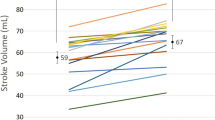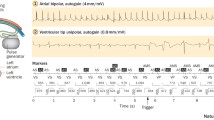Abstract
Background
Right ventricular (RV) pacing increases the incidence of atrial fibrillation (AF) and hospitalization rate for heart failure. Many patients with sinus node dysfunction (SND) are implanted with a DDDR pacemaker to ensure the treatment of slowly conducted atrial fibrillation and atrioventricular (AV) block. Many pacemakers are never reprogrammed after implantation. This study aims to evaluate the effectiveness of programming DDIR with a long AV delay in patients with SND and preserved AV conduction as a possible strategy to reduce RV pacing in comparison with a nominal DDDR setting including an AV search hysteresis.
Methods
In 61 patients (70 ± 10 years, 34 male, PR < 200 ms, AV-Wenckebach rate at ≥130 bpm) with symptomatic SND a DDDR pacemaker was implanted. The cumulative prevalence of right ventricular pacing was assessed according to the pacemaker counter in the nominal DDDR-Mode (AV delay 150/120 ms after atrial pacing/sensing, AV search hysteresis active) during the first postoperative days and in DDIR with an individually programmed long fixed AV delay after 100 days (median).
Results
With the nominal DDDR mode the median incidence of right ventricular pacing amounted to 25.2%, whereas with DDIR and long AV delay the median prevalence of RV pacing was significantly reduced to 1.1% (P < 0.001). In 30 patients (49%) right ventricular pacing was almost completely (<1%) eliminated, n = 22 (36%) had >1% <20% and n = 4 (7%) had >40% right ventricular pacing. The median PR interval was 161 ms. The median AV interval with DDIR was 280 ms.
Conclusions
The incidence of right ventricular pacing in patients with SND and preserved AV conduction, who are treated with a dual chamber pacemaker, can significantly be reduced by programming DDIR with a long, individually adapted AV delay when compared with a nominal DDDR setting, but nonetheless in some patients this strategy produces a high proportion of disadvantageous RV pacing. The DDIR mode with long AV delay provides an effective strategy to reduce unnecessary right ventricular pacing but the effect has to be verified in every single patient.




Similar content being viewed by others
References
Adomian G, Beazell J (1986) Myofibrillar disarray produced in normal hearts by chronic electrical pacing. Am Heart J 112:79–83
Andersen HR, Nielsen JC, Thomsen PE et al (1998) Atrioventricular conduction during long term follow-up of patients with sick sinus syndrome. Circulation 98:1315–1321
Andersen HR, Svendsen JH, on behalf of the DAN-PACE-Investigators (2001) The danish multicenter randomised study on atrial inhibited versus dual chamber pacing in sick sinus syndrome the DAN-PACE-study. Heart Drug 1:67–70
Cowell R, Morris-Thurgood J, Ilsley C, Paul V (1994) Septal short atrioventricular delay pacing: additional hemodynamic improvements in heart failure. Pacing Clin Electrophysiol 17:1980–1983
Delhaas T, Arts T, Prinzen FW, Reneman RS (1994) Regional fibre stress- fibre strain area as estimate of regional oxygen demand in the canine heart. J Physiol 477:481–496
Dennis MJ, Sparks PB (2004) Pacemaker mediated tachykardia as a complication of the autointrinsic conduction search function. Pacing Clin Electrophysiol 27(1):824–826
de Teresa E, Gómez-Doblas JJ, Lamas G, et al. (2007) Preventing ventricular dysfunction in pacemaker patients without advanced heart failure: rationale and design of the PREVENT-HF study. Europace. 9:442–446
Funck RC, Blanc JJ, Mueller HH, et al (2006) BioPace study group biventricular stimulation to prevent cardiac desynchronization: rationale, design, and endpoints of the ‘biventricular pacing for atrioventricular block to prevent cardiac desynchronization biopace’ study. Europace 8:629–635
Janosik D, Pearson A, Buckingham T, Labovitz A, Reed R (1989) The hemodynamic benefit of differential atrioventricular delay intervals for sensed ad paced atrial events during physiologic pacing. J Am Coll Cardiol 14:499–507
Lemke B, Nowak B, Pfeiffer D (2005) Leitlinien zur Herzschrittmachertherapie. Z Kardiol 94:704–720
Lee MA, Dea MW, Langberg JJ et al (1994) Effects of long-term right ventricular apical pacing on the left ventricular perfusion innervation function and histology. J Am Coll Cardiol 24:225–232
Melzer C, Sowelam S, Scheldon TJ et al (2005) Reduction of right ventricular pacing in patients with sinus node dysfunktion using an enhanced search AV algorithm. Pacing Clin Electrophysiol 28:521–527
Müller-Nordhorn J, Schüler G, Roll S, Willich SN (2006) Implantation of a cardiac pacemaker—comparison of subjective stress and mood between in- and outpatients. Clin Res Cardiol 95:539–546
Nielsen JC, Bottcher M, Nielsen TT et al (2000) Regional myocardial blood flow in patients with sick sinus syndrome randomized to long-term single chamber or dual chamber pacing- effect of pacing mode and rate. J Am Coll Cardiol 35:1453–1461
Nielsen JC, Kristensen L, Andersen HR, Mortensen PT, Pedersen OL, Pedersen AK (2003) A randomized comparison of atrial and dual-chamber pacing in 177 consecutive patients with sick sinus syndrome: echocardiographic and clinical outcome. J Am Coll Cardiol 42:614–623
Nielsen JC, Pedersen AK, Mortensen PT, Andersen HR (1999) Programming a fixed long atrioventricular delay is not effective in preventing ventricular pacing in patients with sick sinus syndrome. Europace 2:113–120
Owen CH, Esposito DJ, Davis JW, Glower DD (1998) The effects of ventricular pacing on left ventricular geometry, function, myocardial oxygen consumption, end efficiency of contraction in conscious dogs. Pacing Clin Electrophysiol 21:1417–1429
Prinzen FW, Cheriex EC, Delhaas T et al (1995) Asymmetric thickness of the left ventricular wall resulting from asynchronous electric activation: a study in dogs with ventricular pacing and in patients with left bundle branch block. Am Heart J 130:1045–1053
Savoure A, Fröhlig G, Galley D et al (2005) A new dual chamber pacing mode to minimize ventricular pacing. Pacing Clin Electrophysiol 28:43–46
Sgarbossa E, Pinski SL, Wilkoff BL, Castle LW, Trohman RG, Maloney JD (1993) Is programming a long AV-delay effective in permitting spontaneous ventricular activation? Pacing Clin Electrophysiol 16:872
Sharma AD, Rizo-Patron C, Hallstrom AP et al (2005) Percent right ventricular pacing predicts outcomes in the DAVID trial. Heart Rhythm. 2:830–834
Steinberg JS, Fischer A, Wang P, et al (2005) The clinical implications of cumulative right ventricular pacing in the multicenter automatic defibrillator trial II. J Cardiovasc Electrophysiol 16:359–365
Strohmer B, Pichler M, Froemmel M, Migschitz M, Hintriger F, On behalf of the ELVIS study Group (2004) Evaluation of atrial conduction time at various sites of right atrial pacing and influence on atrioventricular delay optimization by surface electrocardiography. Pacing Clin Electrophysiol 27:468–474
Sutton R, Kenny R (1986) The natural history of sick sinus syndrome. Pacing Clin Electrophysiol 9:1110–1114
Sweeney MO, Bank AJ, Nsah E, et al (2007) Minimizing ventricular pacing to reduce atrial fibrillation in sinus-node disease. N Engl J Med 357:1000–1008
Sweeney MO, Hellkamp AS, Ellenbogen KA, et al (2003) Adverse effect of ventricular pacing on heart failure and atrial fibrillation among patients with normal baseline QRS duration in a clinical trial of pacemaker therapy for sick sinus dysfunction. Circulation 107:2932–2937
Sweeney MO, Ellenbogen KA, Casavant D et al (2005) Multicenter, prospective, randomized safety and efficacy study of a new atrial-based managed ventricular pacing mode (MVP) in dual chamber ICDs. J Cardiovasc Electrophysiol 16:1–7
Tomaske M, Harpes P, Pretre R, Dodge-Khatami A, Bauersfeld U (2007) Evolution of paced QRS and QTc intervals in children with epicardial pacing leads. Clin Res Cardiol 96:787–793
Tse HF, Lau CP (1997) Long-term effect of right ventricular pacing on myocardial perfusion and function. J Am Coll Cardiol 29:744–749
Van Oosterhout MFM, Prinzen FW, Arts T et al (1998) Asynchronous electrical activation induces asymmetrical hypertrophy of the left ventricular wall. Circulation 98:588–595
Wilkoff BL, Cook JR, Epstein AE et al (2002) Dual-chamber pacing or ventricular backup pacing in patients with an implantable defibrillator: the dual chamber and VVI implantable defibrillator (DAVID) trial. JAMA 288:3115–3123
Willems S, Eckardt L, Hoffmann E, Klemm H, Pitschner HF, Reithmann C, Tebbenjohanns J, Zrenner B (2007) Leitlinie invasive elektrophysiologische Diagnostik. Clin Res Cardiol 96:634–651
Author information
Authors and Affiliations
Corresponding author
Rights and permissions
About this article
Cite this article
Nitardy, A., Langreck, H., Dietz, R. et al. Reduction of right ventricular pacing in patients with sinus node dysfunction through programming a long atrioventricular delay along with the DDIR mode. Clin Res Cardiol 98, 25–32 (2009). https://doi.org/10.1007/s00392-008-0716-z
Received:
Accepted:
Published:
Issue Date:
DOI: https://doi.org/10.1007/s00392-008-0716-z




